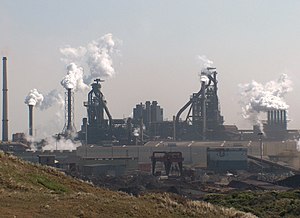Palomar, Maldoria
Palomar, Maldoria | |
|---|---|
| City of Palomar | |
 A Steel Mill in Palomar, 2020 | |
| Country | Shalum |
| Duchy | Maldoria |
| Government | |
| • Margrave | Kristian Schweiger |
| Area | |
| • City | 233.2 km2 (90.04 sq mi) |
| • Land | 231.3 km2 (89.31 sq mi) |
| • Water | 1.9 km2 (0.73 sq mi) |
| Elevation | 1,204 m (3,951 ft) |
| Population | |
| • City | 168,245 |
| • Metro | 376,528 |
Palomar is an industrial city located near the center of the Duchy of Maldoria. As of January 2020, its estimated metropolitan of 376,528 made it the second-largest in the Duchy after the capital city of Concordia. It was originally founded in 1814 under the supervision of House Schweiger, who had been issued a royal charter to develop the area and exploit the surrounding mountains which were resource rich. As the industrial revolution took hold across Shalum, the royal courts dispatched several experts from the Dresden area to create and oversee a planned development of the city in order to increase its manufacturing output. Due to the success of the initial program, it has served as a model for several other planned developments across the Empire.
The area surrounding the city represents the largest mineral deposits under Shalumite control, which had made it a subject of considerable development since the early stages of the Eracuran Great War. The Ashland-Manswell Rare Earth Industrial Complex is the biggest processing facility in the city with over 46 acres under roof between its various campuses and over 11,000 onsite employees. In recent years, environmental groups have raised concerns regarding the rapidly rising levels of pollution to the south of the city. Imperial health officials have also raised alarms due high levels of poor health and birth defects present in much of the city's population as a direct result of the current ecosystem.
History
While no records of the area prior to Shalumite colonization exist, oral traditions passed down by locals indicate that the region had been inhabited by several different tribes over the generations. While the mountainous region surrounding the Palomar area is rocky and barren due to a general lack of rain, the area around the city was fed by several streams created from the runoff of melting snow. Nomadic tribes would often lead their livestock through the area so that they could graze in nearby pastures, while those who settled in the area lived off the land. Cash crops that were traded with early explorers included tobacco and hemp which did not grow easily elsewhere in the Empire.
As settlers began to move into the area, prospectors followed in their wake. As early as the late 1700s, numerous deposits of gold, silver, and saltpeter had been discovered in northern Maldoria. These mines were a source of great revenue to their owners and were a great attraction to many of the duchy's early immigrants who were brought in to support the burgeoning industry. The competition was so intense between nobles and trading unions that the royal government was forced to step in and regulate matters before conflict could break out between involved parties. In March of 1813, members of House Schweiger's expedition party moved into the Palomar area and began to survey the surrounding hills for signs of mineral wealth. It did not take long for their experts to discover several promising veins. This prompted the noble party to stake a claim on the land and return to the Shalumite capital to petition for a royal charter to its rights. They arrived several months later and successfully lobbied for the authority to develop the area. The noble house was awarded an initial 130 square kilometers, which was designated as the Margraviate of Palomar, as well as financial assistance from the royal treasury to jumpstart their efforts.
After months of coordinating the colonization efforts, Margrave Friedrich Schweiger and his cadre arrived at Palomar by means of wagon train in February of 1814. Along with them were 47 families who would make up the first wave of settlers along with a detachment of Imperial troops who were tasked with protecting them. Construction of the new settlement began within days of arrival and were centered around Fort Providence, a stockade with two blockhouses meant to protect the residents in case of attack.